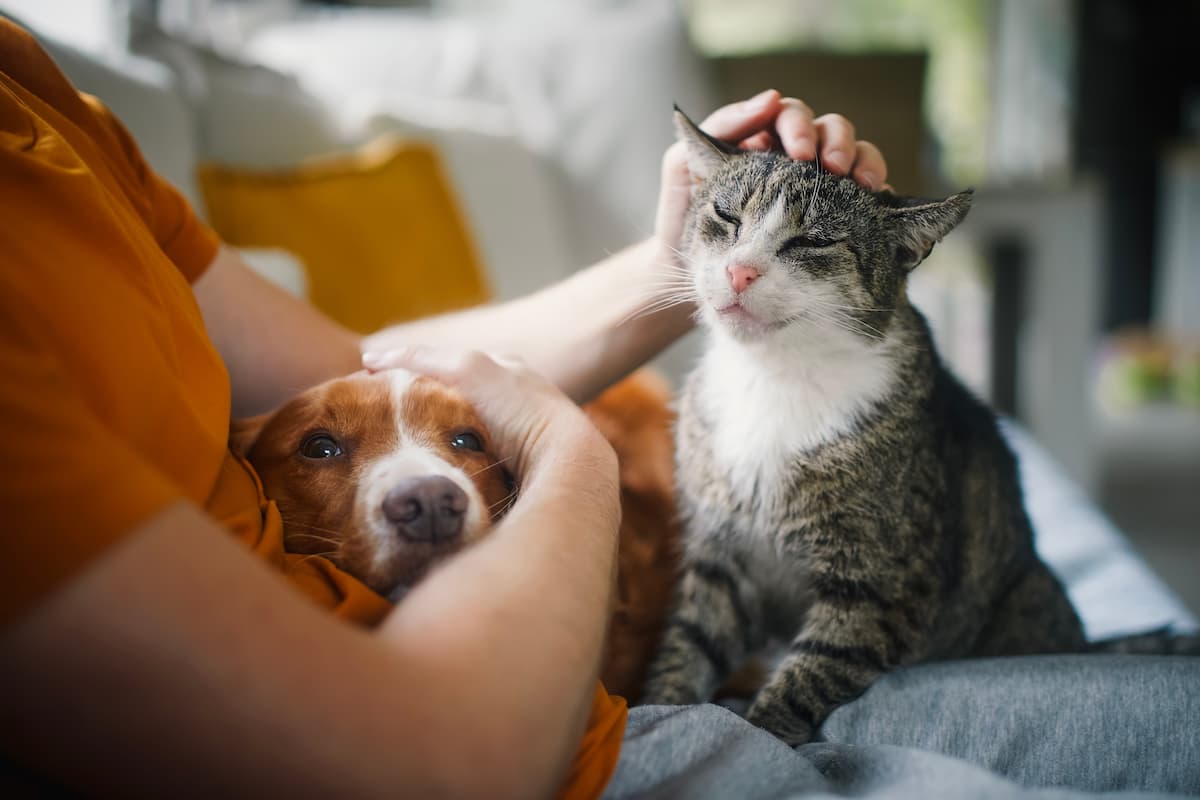Have you ever considered opening your home to a pet temporarily? Pet fostering is a compassionate and increasingly popular way to help animals in need, offering them a safe and nurturing environment until they find their forever homes.
For many Australians, fostering provides a unique opportunity to assess whether pet ownership fits into their lives and can involve a range of pets, from cats and dogs, to more exotic birds, rabbits, guinea pigs and a range of other animals that may need homes. Whether you’re testing the waters of pet care or simply aiming to make a difference, fostering can be a deeply rewarding experience.
 What is pet fostering?
What is pet fostering?
Pet fostering involves temporarily caring for animals from shelters or rescue organisations until they are adopted. The primary objective of fostering is to provide these animals with care, socialisation, and love, which can significantly increase their chances of being adopted.
Foster pet parents play a crucial role in the animal’s life by offering a less stressful environment than a shelter, which greatly benefits the animal’s overall well-being.
Fostering is inherently temporary, varying from a few weeks to several months, depending on the pet’s needs and the adoption rates at the shelter. This arrangement not only helps to reduce overcrowding in shelters but also prepares pets for a smoother transition to permanent homes.
The types of animals in need of fostering extend far beyond dogs and cats. Many shelters also seek foster homes for rabbits, birds, guinea pigs, and even more exotic pets who await adoption. Each type of animal comes with its own set of care requirements and rewards, making fostering a diverse and enriching experience.
By opening your home temporarily, you’re not just helping an animal in need; you’re also making a profound community impact. To learn more about how you can get involved, check out the RSPCA’s fostering resources or explore further at Mad Paws’ blog on fostering a dog, where you can find additional details and stories to inspire your fostering journey.
Fostering vs. adopting pets: What’s the difference?
When considering bringing a new pet into your life, you might find yourself weighing the options between fostering and adopting. Both paths provide invaluable support to animals in need, but they cater to different lifestyles and levels of commitment.
Key differences
The primary difference between fostering and adopting lies in the permanency of the arrangement. Fostering is temporary, providing short-term care to animals until they are adopted by a permanent family. Adoption, on the other hand, is a long-term commitment where you provide a forever home to an animal.
Commitment and responsibilities
Fostering requires a flexible approach to pet care, as you might be caring for different animals for varying periods. The responsibilities can range from basic care, like feeding and exercising, to more involved tasks such as administering medication, training, or socialising the animal to improve its chances of adoption.
Shelters often provide the necessary supplies and cover medical expenses, making fostering a less financially burdensome commitment.
Adopting a pet demands a long-term emotional and financial commitment, as you become fully responsible for the animal’s health and well-being for the rest of its life. This includes regular veterinary care, nutrition, training, and other pet-related expenses, which can add up over time.
A step towards pet adoption
For many, fostering serves as a trial period to assess whether they are ready for the full-time responsibilities of pet ownership. It allows potential pet owners to understand the demands of caring for an animal and to gauge how well a new pet might fit into their lifestyle and household.
Fostering can be particularly helpful as it exposes foster parents to a range of pet behaviours and needs, which can be key in deciding the pet is one that suits your home, lifestyle, and environment,
Fostering before adopting can lead to a more informed, confident decision when choosing to permanently welcome a pet into your home. For more insights and stories about the impact of fostering and adopting, you can read through heartfelt adoption stories.
Ultimately, whether you choose to foster or adopt, you are providing an invaluable service to the welfare of animals and enriching your life with the joy and love that pets bring.
Benefits of fostering a pet
Fostering a pet comes with a host of advantages that extend beyond the simple joy of having an animal around the house.
These benefits can be categorised into emotional, practical, and community impacts, each contributing to the profound fulfilment that animal fostering offers.
Emotional benefits
The emotional rewards of fostering are immense. As a foster carer, you experience the deep satisfaction of helping a pet in need. Many animals in shelters have gone through stressful experiences, and fostering provides them with a loving, stable environment where they can recuperate and thrive. This process can be incredibly heartwarming and enriching.
Also, fostering offers companionship without the long-term commitment of pet ownership, making it a good option for those who love animals but aren’t ready or able to commit permanently.
Practical benefits
Fostering also serves as an excellent way to assess pet compatibility, especially if you are considering adopting in the future. It allows you to understand what type of pet suits your lifestyle, how much time and effort you can dedicate, and how well a pet can integrate into your family.
Moreover, it’s an opportunity to learn pet care basics under less permanent conditions. This includes routine care practices like feeding, grooming, training, and administering medications, all supported and often financed by the animal shelter.
Community impact
On a larger scale, fostering has a significant positive impact on the community. By temporarily housing pets, foster carers help to ease the burden on local shelters and rescue organisations, freeing up resources and space for other needy animals.
Furthermore, fostering increases a pet’s chances of being adopted by helping it adjust to home environments, improving its social skills, and maintaining its health—all of which make it more attractive to potential adopters.
If you’re inspired to start your journey as a foster pet parent, consider reading more about the process and benefits at Mad Paws’ article on why you should adopt a pet, which also touches upon the transformative power of fostering.
 How to become a foster pet parent in Australia
How to become a foster pet parent in Australia
Becoming a foster pet parent in Australia is a rewarding journey that starts with understanding the responsibilities and commitments involved. Here’s a step-by-step guide on how to get started, including what you’ll need to consider and where you can apply to become a foster carer.
1. Research and select an organisation
The first step is to identify local shelters or rescue organisations that offer fostering programs. Many organisations, including the RSPCA and numerous local rescue groups, actively seek foster carers to help care for animals until they can be permanently re-homed.
2. Understand the requirements
Fostering a pet requires more than just time and love. Potential foster parents need to ensure their home environment is suitable for the specific needs of the pet they wish to foster. This includes having secure, pet-safe areas and, in some cases, being able to accommodate the pet’s medical needs or behavioural training. Additionally, you should consider your daily schedule and lifestyle to ensure you can provide the necessary time and attention your foster pet will need.
3. Complete an application
Once you have chosen an organisation, the next step is to fill out a fostering application. This form will ask about your experience with pets, your home environment, and other details to help the organisation match you with the right pet.
4. Attend training and interviews
Most organisations require potential foster carers to attend a training session or workshop. These sessions provide valuable information on the basics of pet care, how to handle emergency situations, and specific training related to the care of more vulnerable animals, such as puppies, kittens, or those with health issues.
You may also be interviewed by the shelter staff to further assess your suitability as a foster carer.
5. Home inspection
A home inspection might be necessary to ensure your living conditions are safe and appropriate for a foster pet. This is also a great opportunity for you to ask any questions you might have about the practical aspects of fostering.
6. Approval and matching
Once approved, the organisation will match you with a pet that suits your home environment and lifestyle. The matching process is critical to ensure both you and the pet have the best fostering experience possible.
7. Bringing your foster pet home
With all steps completed, you’re ready to bring your foster pet home. The fostering organisation will typically provide you with all the necessary supplies, such as food, bedding, toys, and medication if required.
8. Ongoing support
After you have started fostering, the organisation usually provides ongoing support to help you throughout your fostering journey. This includes access to veterinary care and advice on behavioural issues.
If you’re ready to take the first step towards becoming a foster pet parent, visit the RSPCA Australia fostering page to learn more about the opportunities available and to apply. Alternatively, local shelters such as Pet Rescue provide detailed guides and applications to help you get started.
Fostering a pet can be one of the most fulfilling experiences, offering a vital service to animals in need while enriching your own life with the joys of pet companionship.
To start your journey as a foster pet parent, consider reading more about the process and benefits at Mad Paws’ article on why you should adopt a pet, which also touches upon the transformative power of fostering.
 Frequently Asked Questions (FAQs) about pet fostering in Australia
Frequently Asked Questions (FAQs) about pet fostering in Australia
What is the cost of fostering a pet?
Fostering a pet typically involves minimal costs for the foster parent. Most animal shelters and rescue organisations cover the major expenses related to the pet’s care, including veterinary bills, medications, and sometimes even food and supplies.
Nevertheless, foster carers are generally only responsible for providing a safe, nurturing environment and covering daily costs like food if not provided. Remember, fostering an animal is an act of love and these daily costs can pile up. So only foster animals that fit comfortably within your budget to care for.
What happens if I want to adopt my foster pet?
Many foster carers fall in love with their foster pet and decide to adopt them permanently. This process is often referred to as a “foster fail,” but it’s seen as a positive outcome. If you wish to adopt your foster pet, you’ll need to communicate your intentions to the organisation you’re fostering through, and they’ll guide you through the adoption process.
How long does the fostering period typically last?
The duration of the fostering period can vary widely depending on the specific needs of the pet and the organisation’s policies. It could be as short as a few weeks or as long as several months. The fostering period also depends on factors like the pet’s health, age, and how quickly a suitable forever home is found.
Do you get paid to foster a pet?
Fostering is a volunteer activity, and as such, foster carers do not receive monetary compensation. However, most organisations cover all veterinary expenses and, in many cases, also provide food and necessary supplies.
Can you foster a pet if you have anxiety?
Yes, you can foster a pet even if you have anxiety. In fact, many people find that fostering pets has therapeutic benefits, as pets can provide companionship, reduce stress, and increase overall emotional well-being. It’s important to assess your own capacity and choose a pet whose needs are manageable for you.
Can you foster to adopt a pet in Australia?
Yes, in Australia, the “foster to adopt” scheme is quite popular among rescue organisations. This process allows potential adopters to bring a pet into their home on a trial basis to ensure that the pet is a good fit for their household before making the adoption permanent.
How do you deal with guilt for surrendering a pet?
Surrendering a pet can be a difficult decision, but it’s important to recognise when it’s in the best interest of the pet. To cope with feelings of guilt, it’s beneficial to ensure that you’re surrendering to a reputable organisation that will take good care of the animal and work to find it a suitable home.
Communicating openly with the shelter about the reasons for surrender can help them better accommodate the pet. Seeking support from pet support groups or counselling can also be helpful in managing these feelings.
Discover how pet fostering is rewarding for you and them
Fostering a pet offers a unique blend of rewards and challenges. As a foster carer, you provide a crucial bridge to a better life for animals in need, helping to prepare them for adoption into loving homes. The experience brings immense emotional rewards through companionship and the joy of making a significant difference in an animal’s life.
However, it also requires commitment, flexibility, and patience as you work with pets who may have special needs or require extra care and training.
If you’re looking for a fulfilling way to contribute to animal welfare, consider becoming a foster pet parent. It’s an enriching experience that not only benefits the animals but also provides personal satisfaction and growth.

